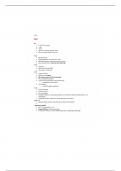1/16
ABG
Ph
7.35-7.45 Is normal
> alka
<acid
diarrhea, vomiting, fasting= acidic
alka- too many diuretics, K is low.
PaO2
80-100 normal
hyperventilation, too much O2= >100
<80 high altitudes, resp depression, poisoning
wont measure heme. Pulse ox wont match up
SaO2
pulse ox!
Normal is 95% and 100%
<95, anemic. COPD, etc
pCO2
normal is 35-45
higher end is acidotic
this is the amount of CO2 in the blood
this is respiratory acidosis
causes of increased pCO2 is decreased resps
o emphysema, pneumonia
<35, alkalosis
o caused by hyperventilation
hCO3
meausres bicarb
normal is 22-26
this is metabolic
metabolic alkalosis- caused by giving too much sodium bicarb (treating acidosis, over
medicating)
metabolic acidosis- patient has severe diarrhea, pancreatitis
patient hx
patients taking diuretics and antacids can throw off metabolic
respiratory acidosis
pH <7.35 and pCO2 Is > 45
hypoventilation. Poor gas exchange
pt has pulm emboli, not deeo breathing bc pain, not good gas exchange.
, 1 broad cause- retention of CO2 bc bad gas exchange
S/S
o Dyspnea, resp distress, shallow resps, confusion/restless, headache, lethargy,
muscle weakness
o Can supplement w O2, PROBABLY won’t help
Need to resolve pneumonia or problem to allow gas exchange
Resp alkalosis
Ph greater than .45 and PaCO2 is less than 35
Hyperventilation
Fear, anxiety, pregnancy, CNS issues
S/s
o Numbness, tingling, lightheadedness, agitation, confusion, positive trausseus
(inflated BP cuff, hand inverts) and chovtek sign (touch face and muscle twitch).
dysrhythmias, increased HR, thread peripheral pulse. Increased RR
Treatment- resolve underlying issue
Pt will get tired after hyperventilation, might need ventilator. Remember body is
compensating for condition by increasing RR
Metabolic acidosis
Ph <.35 and bicarb <22
Respiratory opposite, metabolic equal ROME
o Met acid- both are low
Caused by either deficient in base or excess of acid
o Renal failure, DKA, anaerobic metabolism, starvation, aspirin OD
S/S
o Headache, confusion, kussmaul resp (deep and rapid resps) N/V
Treat underlying cause- ex: diarrhea
o Rehydrate, antidiarrheal meds
o DKA- treat w insulin
o Can administer bicarb- be careful w it. Can send them into opposite
Nursing priorities
Know and treat underlying cause
Check ABG’s often
Metabolic alkalosis
>7.45 bicarb >26
increase in base or decrease in acids
causes: too many tums, too much bicarb- dialysis patients. Make dose adjustments
loss of aids- prolonged vomiting, gastric suction, hypochloremia, excess thiazide diuretics
(HTCZ), high aldosterone
S/S
o Resp depression, dizzy, lethargy, seizures, muscle twitching/weakness/cramps,
N/V
Difficult to treat
Steps to solve
, ROME
Increased pH, Decreased C02 = Respiratory Alkalosis
Decreased pH, Increased C02 = Respiratory Acidosis
Increased pH, Increased HC03 = Metabolic Alkalosis
Decreased pH, Decreased HC03 = Metabolic Acidosis
Step one
pH 7.30 (7.35-7.45) ACID
pCO2 55 (35-45) ACID = Lungs
HCO3 26 (22-26) NORMAL = Kidneys
Match the two abnormalities: Respiratory (lung problem) + Acidosis = Respiratory
Acidosis.
**Ph not in normal range= uncompensated or partially compensated
when pH is normal (fully compensated), use the 7.40 rule
< .40 = acid
>.40= alka
Ex:
pH 7.38 (7.40) normal but NOW ACIDOSIS
PaCO2 56 (35-45) ACIDOSIS = Lungs
HCO3 35 (22-26) ALKALOSIS
Match the two abnormalities: Respiratory (lungs) + Acidosis = Respiratory Acidosis
remember ROME. Resp opposite. pH is low, PaCO2 is high
this patient is in normal range, compensated resp acidosis
**examples in pptx
partially is all 3 are abnormal!
1/18/19
care of the pt w hematological problems
hgb- gas carry capacity RBC
hct- packed cell volume of rbcs expressed as a % of the total blood volume
reticulocyte- measure of immature RBC (bone marrow activity)
iron- amount of iron combined w proteins in serum: accurate indicator of status of iron storage
and use
Serum Ferritin: Major iron storage protein; normally present in blood in concentrations directly
related to iron storage
, Total Iron-Binding Capacity (TIBC): Measurement of all proteins available for binding iron;
transferrin represents the largest quantity of iron-binding proteins; therefore TIBC is an indirect
measure of transferrin; evaluation of the amount of extra iron that can be carried
Myelosuppression-
neutropenia, leukopenia, anemia, thrombocytopenia, pancytopenia
neutropenia/leukopenia
very low neutrophil count
neutrophils fight stuff off
worry about immunosuppression and infection
o at rx for these
rx factors
o age (elderly)
o renal and liver function
o Nutrition!!!
Deficiencies
o bone marrow
o medications
chemo
o prior chemotherapy and/or radiation
o environmental (nosocomial)
o organisms (bacterial, viral, fungal)
o nosocomial infections/
leukopenia is more broad
manifestations: can tell if patients have neutropenia if
o cough, fever, urinary retention, rash
o usually can tell they’re not getting better, do lab work
need a thourough assessment every shift.
o Neuro
o Circ
o Skin
o Mucus/ mouth
o ETC
Absolute neutrophil count
**most reliable
Grade 0 = ANC WNL
Grade 1 = >1500 and <2000
Grade 2 = >1000 and <1500
Grade 3 = >500 and < 1000
Grade 4 = <500
o Grade 4 is really bad. Put them in precautions, worried about infections
Interventions if neutropenic




